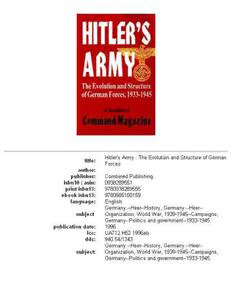
Hitler's army: the evolution and structure of German forces PDF
01996·3.824 MB·English
Most books are stored in the elastic cloud where traffic is expensive. For this reason, we have a limit on daily download.
Preview Hitler's army: the evolution and structure of German forces
Description:
Adolf Hitler was named Chancellor of Germany in 1933, but did not fully consolidate his power until the summer of 1934, when he brutally suppressed the Nazi Party's private militia in an agreement with the regular German armed forces. Thus began a contradictory relationship between Party and Army that continued until the very end of the National Socialist regime in 1945.Hitler's Army features a unique blend of graphics and text that brings a fresh approach to the development of the German Army under the Third Reich. The most technically sophisticated charts, tables of organization and maps available graphically illustrate the structural evolution of the most intensely-studied army of the twentieth century. An insightful main text shows how the Wehrmacht's structure was increasingly contradictory to the military missions Hitler ordered it to undertake.Hitler's Army also includes a novel analytical comparison of the U.S. and German armies in World War II, covering both organization and battlefield performance. The Luftwaffe field divisions, Waffen-SS units, and foreign volunteers that supplemented the regular German army are also given detailed coverage.Innovative German weapons such as assault guns, tank destroyers and rocket artillery are covered, and discussed in the context of German operational doctrine. The reality of German reliance on horse-drawn transport, the negative role of political interference and in-fighting, and other often-ignored impediments to German operations are candidly assessed. Twelve key engagements, from Czechoslovakia 1938 to Berlin 1945, have been selected to show German organization and doctrine tested in action. For tactically significant battles like Demyansk, Narva, and Budapest 1945, readers will find much information not readily available in the English-speaking world.
See more
The list of books you might like
Most books are stored in the elastic cloud where traffic is expensive. For this reason, we have a limit on daily download.
